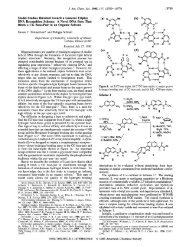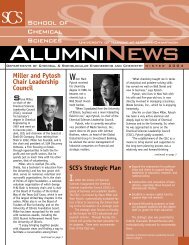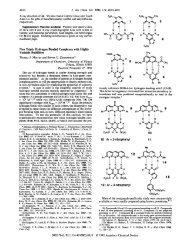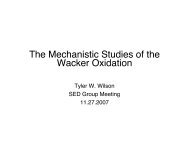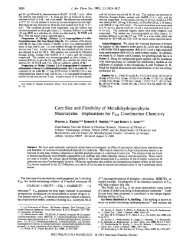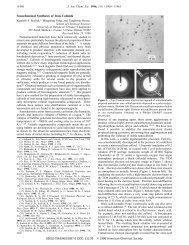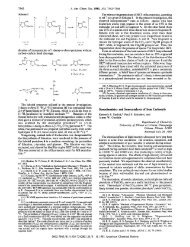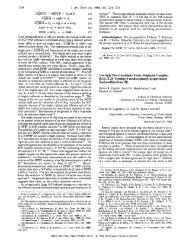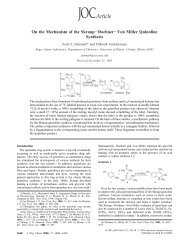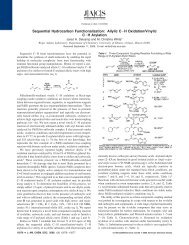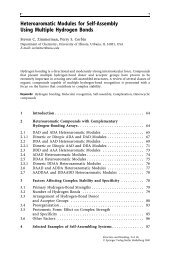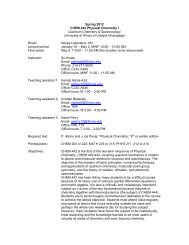FRIEDLIEB RUNGE AND HIS CAPILLARY DESIGNS
FRIEDLIEB RUNGE AND HIS CAPILLARY DESIGNS
FRIEDLIEB RUNGE AND HIS CAPILLARY DESIGNS
You also want an ePaper? Increase the reach of your titles
YUMPU automatically turns print PDFs into web optimized ePapers that Google loves.
30 Bull. Hist. Chem., VOLUME 30, Number 1 (2005)<br />
The chemical sciences in<br />
modern times owe no<br />
small debt to the development<br />
of improvements in<br />
analytical techniques.<br />
Chromatographic methods,<br />
in particular, have<br />
served as successful, systematic<br />
separations in<br />
chemistry, biology, and<br />
biochemistry. The founder<br />
of chromatography is recognized<br />
as the Russian<br />
botanist M. S. Tswett (1),<br />
who in 1906 applied the<br />
concept of “chromatography”<br />
for the first time. In<br />
1941 the work of British<br />
chemists A. J. P. Martin<br />
and R. L. M. Synge (2) became<br />
world renowned;<br />
they were awarded the<br />
Noble Prize in 1952 for the<br />
development of partition<br />
chromatography.<br />
By contrast the work<br />
of the German chemist F. F.<br />
Runge (1794-1867) has remained<br />
virtually unknown.<br />
About 100 years before<br />
Martin and Synge, he took<br />
<strong>FRIEDLIEB</strong> <strong>RUNGE</strong> <strong>AND</strong> <strong>HIS</strong><br />
<strong>CAPILLARY</strong> <strong>DESIGNS</strong><br />
Ernst F. Schwenk, Wiesbaden, Germany<br />
Title page, Der Bildungstrieb der Stoffe,<br />
Oranienburg, 1855.<br />
advantage of the capillary<br />
action of blotting paper as a<br />
means of visualizing chemical<br />
changes. In his 1855<br />
book, Bildungstrieb der<br />
Stoffe, Runge described<br />
techniques that are the forerunners<br />
of modern paper<br />
chromatography.<br />
Who was Friedlieb<br />
Ferdinand Runge?<br />
The academic and industrial<br />
chemist F. F. Runge was<br />
born on February 8, 1794 in<br />
Billwerder near Hamburg.<br />
After completing an apprenticeship<br />
in pharmacy in<br />
Lübeck, he first studied<br />
medicine in Berlin and then<br />
moved to the university in<br />
Jena, where he concentrated<br />
on plant chemistry. In 1822<br />
he completed his doctoral<br />
studies on toxic plant extracts,<br />
under the direction of<br />
W. Döbereiner (3). He became<br />
Professor of Technical<br />
Chemistry at the University<br />
of Breslau (currently
Bull. Hist. Chem., VOLUME 30, Number 1 (2005) 31<br />
Wrozlaw, Poland) (4) in<br />
1828.<br />
Because he found<br />
the meager salary of a<br />
professor disappointing,<br />
Runge took a position in<br />
1833 at the Chemische<br />
Produktenfabrik in<br />
Oranienburg (5), where<br />
he sought the opportunity<br />
to bring his creativity and<br />
inventiveness to fruition.<br />
As technical director,<br />
Runge had as one of his<br />
assignments finding uses<br />
for coal tar oil, a<br />
byproduct in the manufacture<br />
of illuminating<br />
gas (6). In the process he<br />
discovered and identified<br />
phenol and aniline (7).<br />
Much to his surprise, he<br />
was able to isolate deepred<br />
crystals from the distillation<br />
residue. This<br />
Rosolsäure yielded a brilliant<br />
red dyestuff, the first<br />
synthetic textile colorant,<br />
suitable for dyeing calico and silk fabrics. Further investigations<br />
led Runge to the preparation of violet and<br />
bluedyestuffs. When cotton fibers were impregnated<br />
with aniline and then treated with copper salts and potassium<br />
chromate, there appeared a light-fast black,<br />
which could be reduced with sulfurous acid to an emerald<br />
green.<br />
Title page, Musterbilder für Freunde des Schönen,<br />
Berlin, 1850.<br />
Table. Examples of “Runge Designs”<br />
Runge informed his supervisors<br />
of his discoveries and<br />
proposed building a factory in<br />
Oranienburg for the manufacture<br />
of synthetic dyes and other<br />
coal tar products. This took<br />
place in 1836, indeed 20 years<br />
before the discovery of mauve<br />
(8) by W. Perkin (1856). His<br />
plan fell on deaf ears at general<br />
management in Berlin. He<br />
turned to experimenting with<br />
stearin and paraffin (9) for the<br />
manufacture of candles for domestic<br />
illumination, but his<br />
proposal to build a candle factory<br />
was also denied. Finally,<br />
Runge made the suggestion to<br />
manufacture “synthetic guano”<br />
from bones and other slaughter<br />
house wastes for use in agriculture<br />
(10). His thought was<br />
that the deteriorating fertility of<br />
farmland would afford an opportunity<br />
for a thriving enterprise<br />
and high profits. Once<br />
again, however, his message<br />
went nowhere.<br />
Runge was bitterly disappointed over the denial of<br />
his proposals and the continual disagreements with<br />
higher authorities. He accused the ministerial offices<br />
of scientific ignorance. In response the executive officers<br />
faulted Runge for spending too little time in the factory.<br />
In fact, Runge wrote no fewer than seven textbooks<br />
(11) during his employment, between 1834 and<br />
Solution A “Instrusion Agent” Solution B Result<br />
Pb(III) sulfate — K ferrocyanide deep-blue ring with<br />
brown border<br />
Mn sulfate ammonia K chromate dark brown ring with<br />
light brown border<br />
Cu sulfate (NH 4 )H 2 PO 4 K ferrocyanide red core with green<br />
border
32 Bull. Hist. Chem., VOLUME 30, Number 1 (2005)<br />
1850. The conflict ended in 1851 with his dismissal.<br />
As a pension Runge received 400 Taler (12) annually<br />
and wood to heat his living quarters. In return, he was<br />
required to reside in Oranienburg, “so that one could<br />
seek his professional advice at any time.”<br />
Capillary Designs “for Friends of Beauty”<br />
At the age of 56 Runge could now turn his attention to a<br />
hobby that had long fascinated him: color reactions for<br />
identifying single components in mixtures. The kitchen<br />
of his bachelors’ quarters was converted into a makeshift<br />
laboratory, with cups and plates serving as substitutes<br />
for glass apparatus. He was able to carry out distillations<br />
and concentrations with his coal stove. Having<br />
been barred from his former work place, he found it<br />
necessary to be very sparing in use of chemicals. In this<br />
way he became adept at working with very small quantities<br />
of material: this was analysis on a microscale.<br />
Not wanting to spend his time cleaning test tubes, Runge<br />
came upon the idea of carrying out chemical reactions<br />
on the surface of blotting paper. Thus he developed a<br />
new field of practical chemistry: capillary analysis.<br />
Runge’s technique was conceptually simple: a<br />
wooden frame (roughly 12 x 12 cm.) was wrapped with<br />
cord on which was placed a piece of unsized, adsorbent<br />
paper (Löschpapier) (13). He introduced a solution of<br />
A dropwise by means of a pipet in the center of the paper,<br />
being certain that each drop was taken up individually<br />
by the paper. After the paper had been allowed to<br />
dry, he introduced a solution of B on the exact same<br />
spot. The result was the formation on the paper of deposits<br />
in the form of characteristic rings, bands, or irregular<br />
shapes. The final appearance could be varied at<br />
will by the use of “intrusion agents” [“Störsubstanzen”],<br />
such as ammonia, hydrochloric acid, oxalic acid, or a<br />
small amount of sugar, egg white, or gum arabic. The<br />
resulting “Runge designs” resembled in shape the ameba,<br />
jellyfish, or a wreath.<br />
Runge concluded that the circular images arose:<br />
..durch eine neue, bisher unbekannte Kraft, die mit<br />
Magnetismus, Elektrizität und Galvanismus nichts<br />
gemein habe (“from a new, as yet unrecognized force<br />
but different from magnetism, electricity, or<br />
galvinism.”)<br />
He called this force the “creative drive” (Bildungstrieb)<br />
of matter. Today we recognize Runge as the first to identify<br />
the principle of chromatography, a method for separation<br />
and identification of chemical substances in a complex<br />
mixture. He did not extend this basic principle to<br />
the next logical step-practical analytical applications.<br />
After all, in retirement Runge was assigned no scientific<br />
projects (14).<br />
Runge’s “Picture Patterns” - Rare<br />
Curiosities<br />
Runge’s enthusiasm for the beautiful “color spots”<br />
prompted him to introduce the “spontaneously formed<br />
images” to the public. He encouraged Oranienburg<br />
school children to assist in preparing the images, and<br />
they in turn were thrilled to collaborate with the prominent<br />
scholar. Under Runge’s guidance, thousands of<br />
chromatograms were produced and, together with scientific<br />
explanations, used to embellish books, which<br />
were printed privately in limited editions between 1850<br />
and 1855 (15). What has become of these books? About<br />
20 of these rarities can be found presently in various<br />
libraries, among them:<br />
Philadelphia (Chemist’s Club Library, Chemical<br />
Heritage Foundation)<br />
Philadelphia (Library of the Philosophical Society)<br />
Oberlin, OH (Library of Oberlin College)<br />
New Haven, CT (Yale University Library of Rare<br />
Books)<br />
In his last years Runge turned his attention to everyday<br />
chemistry. He wrote articles of advice on popular and<br />
practical science and its basis in daily work. Tradesmen,<br />
for example, learned that lumber could be protected<br />
effectively against decay by treatment with coal tar oil.<br />
Farmers received advice on the disinfection of cow stalls<br />
with bleaching powder (chloride of lime), and pharmacists<br />
were instructed on the detection of sugar in urine.<br />
Most of the articles were addressed to housewives. They<br />
learned why wool stockings should not be laundered in<br />
hot water and how rust spots could be removed from<br />
white fabrics, namely with oxalic acid. In clear but detailed<br />
form, he offered recipes for rapid marinating of<br />
meat and preparation of an easily digestible cucumber<br />
salad. Runge’s articles were later published in book form<br />
(16), and he was recognized as the “pioneer of popular<br />
chemical formulations.”<br />
In Oranienburg Runge was considered an eccentric,<br />
cranky independent scholar. In 1862, 28 years after<br />
his discovery of coal tar dyes, he was honored with a<br />
high tribute at the Industrial Congress in London, and<br />
he was finally honored in the Prussian capital of Berlin.<br />
He was given honorary membership in chemical societies<br />
and received several honorary degrees and awards.
Bull. Hist. Chem., VOLUME 30, Number 1 (2005) 33<br />
After a short illness, Runge died in his residence in<br />
Oranienburg on March 25, 1867, where he was buried<br />
in the municipal cemetery.<br />
Conclusion<br />
F. F. Runge, one of the first industrial chemists, discovered<br />
and isolated the plant alkaloids quinine, atropine,<br />
catechol, and caffeine. From coal tar oil he was able to<br />
isolate phenol, aniline, quinoline, and thymol. He was<br />
far ahead of his time, having proposed large-scale pro-<br />
Runge’s residence and place of death, Oranienburg<br />
duction of coal tar dyes, wax candles, and synthetic fertilizer.<br />
Had he not been impeded but rather encouraged<br />
by the Prussian bureaucracy, he might today be considered<br />
the founder of pharmaceutical chemistry and coal<br />
tar dyes and fertilizer industries. From his publications,<br />
Runge can be considered the discoverer of capillary<br />
analysis, developed as an analytical tool 100 years later<br />
in the form of paper chromatography.<br />
REFERENCES <strong>AND</strong> NOTES<br />
1. Mikhail Semenovich Tswett (1872-1919), Geneva and<br />
Warsaw.<br />
2. Archer John Porter Martin (1910-2002) and Richard<br />
Laurence Millington Synge (1914-1994). The separated<br />
a mixtures of amino acids from wool hydrolysate on a<br />
column of hydrated silica. Nobel Prize in Chemistry,<br />
1952.<br />
3. Johann Wolfgang Döbereiner (1780-1849), known<br />
among other things for his lamp and for chemical catalysis.<br />
4. In the cholera epidemic in Breslau in 1831 Runge used<br />
bleaching powder for the first time as a disinfectant with<br />
great success, thereby earning high respect from the<br />
population.<br />
5. The “Chemisches Produktenfabrik” in Oranienburg,<br />
north of Berlin, founded in 1802 by the pharmacist G.<br />
Hempel, was the most modern chemical factory in Europe<br />
at that time. It produced sulfuric acid, hydrochloric<br />
acid, soda and in organic pigments. Later a soap<br />
factory (“Oranienburger Soda-Seife” was added.<br />
6. The Oranienburg factory used coal gas from coke for<br />
thee synthesis of ammonia. This coal gas, supplied by<br />
Berliner Gasanstalten, contained residues of coal tar oil,<br />
which at the time was of no value.<br />
7. The concept of phenol or aniline was unknown at the<br />
time; Runge the substances he discovered as<br />
“Carbolsäure (carbo = carbon) and Kyanol (Gr., kyanos<br />
= blue).<br />
8. William Perkin (1838-1907) discovered the first coaltar<br />
dye mauve in 1856 and began commercial production<br />
in 1857, which ushered in the era of synthetic dyes.<br />
9. Runge obtained stearin from imported palm oil and paraffin<br />
from domestic peat. Both raw materials were<br />
cheaper than beeswax then being used for candle manufacture.<br />
10. The idea to make “synthetic guano” from slaughter<br />
wastes originated with J. von Liebig (1803-1873). The<br />
first production of synthetic fertilizer was achieved in<br />
Heufeld, Bavaria and Wiesbaden, Hessen in 1857.<br />
Runge might have begun manufacture and sale of “synthetic<br />
guano” seven years earlier.<br />
11. F. F. Runge, Farbenchemie, Teil I., “Die Kunst zu<br />
färben,” (1834); Teil II., “Die Kunst zu drucken,” (1842);<br />
Teil III., “Die Kunst der Farbenvorbereitung,” (1850),<br />
E. S. Mittler, Berlin. F. F. Runge, Technische Chemie<br />
für Jedermann (1836); F. F. Runge, Technsiche Chemie<br />
der nützlichen Metalle (1838), Verlag Sander’sche<br />
Buchhandlung, Berlin. F. F. Runge, Grundriss der<br />
Chemie, Teile I und II, Verlag Georg Franz, München,<br />
1846, 1847.<br />
12. The Prussian king later granted him an additional 350<br />
Taler annually, in recognition of his contributions to science.<br />
13. The nature of the paper is crucial for the success of the<br />
chromatogram. Thin, unsized, highly absorbent cotton<br />
or linen paper is recommended. It must be homogeneous<br />
and as flat as possible, such that the capillary designs<br />
may freely develop.<br />
14. The “Tüpfelmethode”—spot test—developed by the<br />
Austrian chemist Fritz Feigl (1891-1971) was but a short<br />
step further. Another Austrian chemist, Fritz Pregl (1869-<br />
1930), was awarded the Nobel Prize in Chemistry in 1923<br />
for his development of qualitative and quantitative microanalysis.<br />
15. F. F. Runge, Farbenchemie. Musterbilder für Freunde<br />
des Schönen und zum Gebrauch für Zeichner, Maler,<br />
Verzierer und Zeugdrucker, dargestellt durch chemische<br />
Wechselwirkung, Selbstverlag, Berlin, 1850. F. F.
34 Bull. Hist. Chem., VOLUME 30, Number 1 (2005)<br />
Runge, Der Bildungstrieb der Stoffe, veranschaulicht in<br />
selbstständig gewachsenen Bildern (Fortsetzung der<br />
Musterbilder), Selbstverlag, Oranienburg, 1855.<br />
16. F. F. Runge, Hauswirthschaftliche Briefe,” 1-3, Dutzend<br />
G. A. Koenigs Verlag, Berlin, 1866, Oranienburg, 1867;<br />
reprinted by VCH-Verlag, Leipzig and Weinheim, 1988.<br />
Secondary Sources<br />
1. B. Anft, Runge, seine Leben und Werk, Abhandlungen<br />
zu Geschichte der Naturwissenschaften, Heft 23, Verlag<br />
Ebering, Berlin, 1937.<br />
2. G. Harsch and H. Bussemas, Bilder, die sich selber<br />
malen, Dumont Verlag, Köln, 1985.<br />
3. M. Rehberg, F. F. Runge, Entdecker der Teerfarben,<br />
Oranienburg, 1935, publisher unknown; included in: A.<br />
Grüne, Das Chemische Wappen, zum 100jährigen<br />
Gedächtnis von Runges “Bildungstrieb der Stoffe,”<br />
Schleicher und Schüll, Dassel, 1955.<br />
Runge with his home made gooseberry wine (Photograph<br />
ca 1860, the only one known to exist.)<br />
4. K. A. Schenzinger, Anilin (a novel), Zeitgeschichte-<br />
Verlag Andermann, Berlin, 1936.<br />
5. E. F. Schwenk, Sternstunden der frühen Chemie, Verlag<br />
C. H. Beck, München, 1998 and 2000.<br />
6. J. Zahn, “Dr. Gift und die ersten Anilinfarbstoffe,” in<br />
Farben-Revue, Bayer, Ludwigshaven, 1985, 47 ff.<br />
ABOUT THE AUTHOR<br />
Dr. Ernst F. Schwenk, Odenwaldblick 32, D-65207<br />
Wiesbaden, Germany, was employed from 1957-1987<br />
in chemical industry as production supervisor. Among<br />
several books he has authored on the historical aspects<br />
of technology and science is Sternstunden der frühen<br />
Chemie, von J. R. Glauber bis J. von Liebig. His email:<br />
schwenk-naurod@t-online.de.



